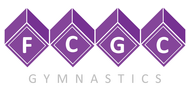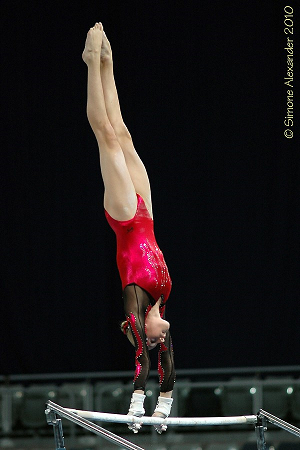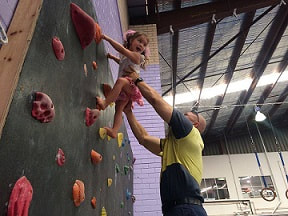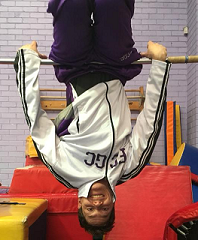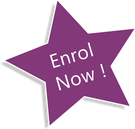|
The press to handstand is one of the most difficult skills to achieve as well as one of the most important in the higher levels of gymnastics. The ‘press’, as it is affectionately known, has a number of different components which can take years to perfect and ultimately result in it’s mastery. The process of learning a press to handstand also develops and teaches valuable skills for life surrounding perseverance, determination and how to trust the process. So, without further ado, lets look at some tips to help you achieve your press to handstand! Like it’s name sake suggests the handstand is all about balancing...upside down! It takes a lot of practice to balance using our hands as though they are our feet. In order to best prepare our bodies to balance upside down we must undertake a lot of wrist conditioning. In our classes at FCGC we utilize the array of equipment on offer to help our gymnast’s develop strength in their wrists. Most of the time these activities are lots of fun for the gymnasts, but really there is purpose to our play. Compressing foam blocks from the foam pit or scrunching scarves with our hands all help to develop our wrist and hand strength. The second vital shape for the handstand which we practice from Geckos and Grown Ups through to Level 10 is our rocket or tall shape. This shape is the most important for a lot of skills, but none more so than the handstand. The gymnast practices standing in a straight line; extending upwards through their shoulders, pressing their ribs ‘inwards’ and pulling their hips ‘under’ to create a perfectly aligned and straight body. When inverted, this shape becomes a perfectly straight handstand which is easy to control and balance in. The next component for a perfect press is core strength. In order to perform a press to handstand it is essential for a gymnast to develop their core stability through a range of exercises. As well as the general gymnastics core conditioning activities including the likes of ‘dish hold’ and leg lifts, there are many exercises which develop core strength in parallel with the press to handstand action. Stalder leg lifts are one such strengthening activity; the gymnast starts hanging on the bar and lifts their legs into an inverted straddle position. When rotated upside down the gymnast looks as though they are starting in a handstand and lowering down to a straddle support position; one of the many ways to start a press to handstand! Another similar drill is a lying press to handstand on a trapezoid shape. This drill not only works the gymnast’s core strength, but also their muscle memory for the skill. In this drill the gymnast begins lying on their back in a stretched position, their hands touching the wall as though in a handstand. Lifting through their hips, the gymnast rolls backwards into a straddle position with their hands still touching the wall. The gymnast then slowly lowers back to their lying stretched handstand position – talk about that for an abdominal work out! As a coach the part I most often see gymnasts struggling with is the all important ‘planche action’ with their shoulders. In order to perform a consistent and technically correct press to handstand a gymnast must lean forwards over their hands through a planche position. The easiest way to think about a planche is like a seesaw; we are trying to counterbalance our bodies through our shoulders. This leaning action is common place throughout gymnastics skills including a ‘cast’ on the Uneven and High Bars, swing to handstand on Parallel Bars and front support on floor. At FCGC we encourage this important progression as early as possible with our gymnasts in order to make these harder skills much easier long-term for our athletes. One shape which can be practiced at home as well as in class is a front support position. In a front support the gymnast should have an ‘angry cat’ rounded chest and lean forward over their hands with their shoulders – this will translate to a comfort of leaning forwards, assist the gymnast with the skills mentioned previously, and their press to handstand! Other exercises which work both the planche action required for the press and core strengthening include; Pike Drag Ups: The gymnast begins in a support shape on a bar or edge of a box and, lifting through their hips whilst leaning forwards, drag their toes up the bar/box to a standing position Elephant Stand: The gymnast begins in a frog position on the floor (squatting with hands in between feet) and rests the inside of their leg on their straight arms. The gymnast then leans forward with a rounded chest and balances for as long as possible Straddle Press Walks: The gymnast begins sitting in a straddle position and lifts their hips up whilst leaning forward over their hands. From the inverted position the gymnast lowers back down through an L-sit and into a straddle and places their hands in front of them ready to go again! Now that we have looked at the different components of the press, its time to put it all together! The gymnast should start in a straddle stand with their back facing a wall, wedge or beat board (leaning against something of course!) placing hands just in front of the vertical surface. From the straddle stand the shoulders should lean forward through the planche phase whilst lifting the toes into the air. Just before vertical the gymnast should dynamically ‘open’ their shoulders to finish in a perfect handstand! Remember that a press to handstand can take many years to achieve, so don’t be pressed with time and start practicing today! See you in the gym – Coach Toby
1 Comment
Every week you take your children to their gymnastics classes - sometimes staying to watch them train. We all know the incredible benefits gymnastics has on children but have you ever thought about what having a child in the gym is teaching you?
How to trust in the process: This is a life lesson for both the parents and gymnasts - kids aren’t going to learn how to flip and somersault their very first lesson which is what most people associate with gymnastics. Instead there is a big foundation of body shaping, body tension, strength and many, many drills before gymnasts start hitting the harder skills. This process is so important to ensure gymnasts don’t hurt themselves throwing skills they are not ready for - however can be slightly frustrating for parents watching. Parents with gymnasts quickly learn that there is a process and how to celebrate the small successes with their children knowing they are one step closer to that skill they really want! Bravery: It can take a brave parent to watch their child do gymnastics for so many different reasons. Gymnasts have to learn to be brave and trust themselves and their coaches, but parents also have to learn this bravery watching their children train skills that they may find scary, knowing you can’t be right there to help. Sometimes this means watching with your heart in your mouth as your child tries that new skill on the high beam for the first time! Watching your gymnasts at competitions or events takes a lot of bravery too - sometimes children forget their routines or fall in their routine - which is all part of gymnastics, but as a parent it can be hard to watch! So I applaud all parents who are able to watch their children train and compete and can stay relatively calm doing so. You are all learning to be so brave on behalf of your children. Learning to watch your child fall: If you’re an experienced gymnastics parents you’re probably nodding your head at this one - if you’re new to the sport it may sound a little crazy. Falling is a massive part of gymnastics but that doesn’t mean it’s easy to watch! Gymnasts first learn how to fall properly before they start doing bigger skills (and yes there is a right and a wrong way to fall). If they know how to fall properly it lowers the chance of injury! Some falls will be funny, some will be frustrating and sometimes a fall can be pretty scary. Parents have to learn to watch these from afar without being able to do anything for their child. This one also links back to bravery as well. Being a gymnastics parent isn’t always easy! Just remember next time your child falls - it’s an important part of the sport and is helping them in the long run, try using positive words when you talk about it after practice. Rip care: Bars, sweet bar. So much fun but also so much ouch! We love bars but yes, they do hurt your hands - especially while in the process of making your hands strong and tough. Sometimes your children come home with a dreaded rip and you have to somehow make it better! I guess we could say gymnastics is teaching you wound care as well, aren’t you lucky! If you are struggling with how to help your child with their rips here are some top tips. 1.Make sure their hands are washed clean to get all the chalk out of the rip 2. Cut of the dead skin surrounding the rip - if this gets left on it can rip more 3. Get a wet tea-bag and have your child hold it on the rip for 5-10 minutes 4. You can put some antiseptic creams on it following this as well 5. Cover the rip for the next practice. If you’re bringing a child to gymnastics we think you’re amazing and are so glad we can help teach you some life lessons too! Thank you for helping support your child's development through this wonderful sport. - Coach Saskia As many people know, FCGC Gymnastics runs an adult gymnastics class but did you know that FCGC Gymnastics also runs an adults gymnastics program for those with differing abilities too? Every Thursday afternoon FCGC Gymnastics facilitates Gymnastics for Adults with varying abilities. Most of our inclusive gymnasts are Adults living with Autism. Majority of these adult gymnasts come from a center with their careers, for a 45 minute class of fun, jumping and physical movement. Like all of our programs, we aim to teach Skills for Life with a big focus on movement and coordination. Along with the ability to listen and follow instructions, to communicate and develop their social skills. We have a structured routine to help keep the adult gymnasts from being overwhelmed. We find it is important that we keep the same class structure each week for our classes, as routine plays a very important part in the life of Autism. The Adults begin with sitting on a box each and we all sing a hello song to welcome everyone. We include ASL (American Sign Language) into our greeting song as well, as many of our individual gymnasts may be non-verbal. After this, we use a hand-held pom pom and we go around the circle and welcome everyone using their names for example “hello sarah” and then sarah can wave. Sarah will then get up and walk to pass it to the next person. It is important to stand up and walk to the next person as this promotes movement. We then go through a warm up that consists of balancing, stretches, hand eye coordination, core stability and upper/ lower body strength. To do this we use hand apparatuses’ such as beanbags, hoops, scarves, foam blocks, coloured mats to assist in the process. From here, they move onto a circuit through the gym which includes jumping, swinging, hanging, climbing, and balancing. We spend some time helping each individual around an area of the gym - encouraging them to have a try at different stations. The trampoline is always a favourite however, so many gymnasts will spend a lot of their time bounding up and down for as long as possible! After this we then use a cue to signal our running activity. For this final activity we run around the circle of boxes from the start to some music. This cue is important for them to know it’s coming to the end of the class. Lastly, we get a large parachute out and wave it up and down and say goodbye. We say goodbye to each individual by using their names, and giving them a moment of recognition in the large group. We at FCGC Gymnastics believes that Gymnastics has the ability to help EVERYONE and for those who have a disability it is an opportunity to build upon social skills, communication skills, fitness, motor skills (gross and fine), mental stimulation and much more. Our coaches develop such strong bonds with all the adults who come into FCGC Gymnastics, and all our coaches really look forward to each Thursday morning in the gym. Thanks for reading today's blog!
Coach Beth. |
Archives
February 2021
Categories
All
|
|
EMAIL
info@fcgc.com.au |
